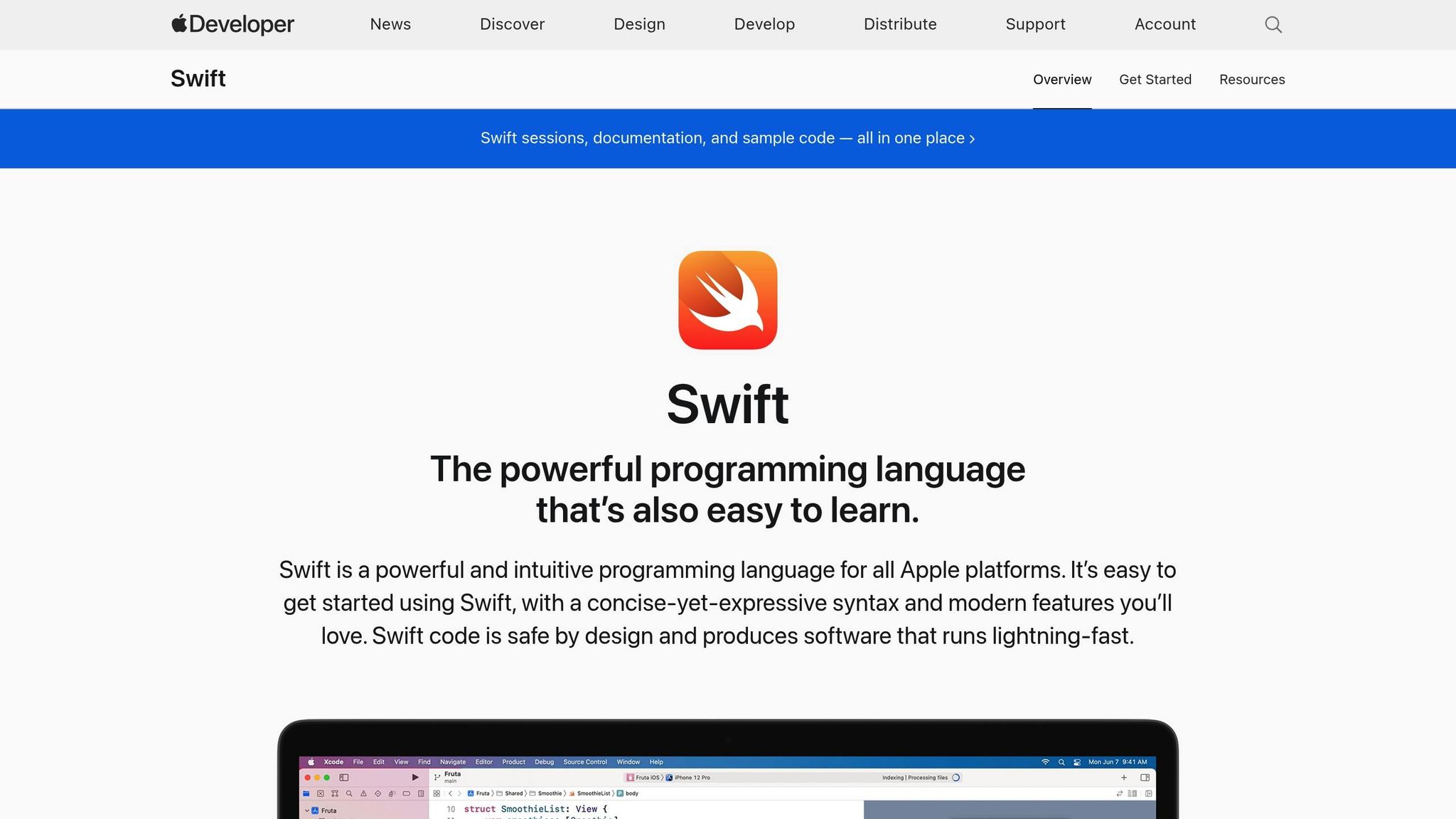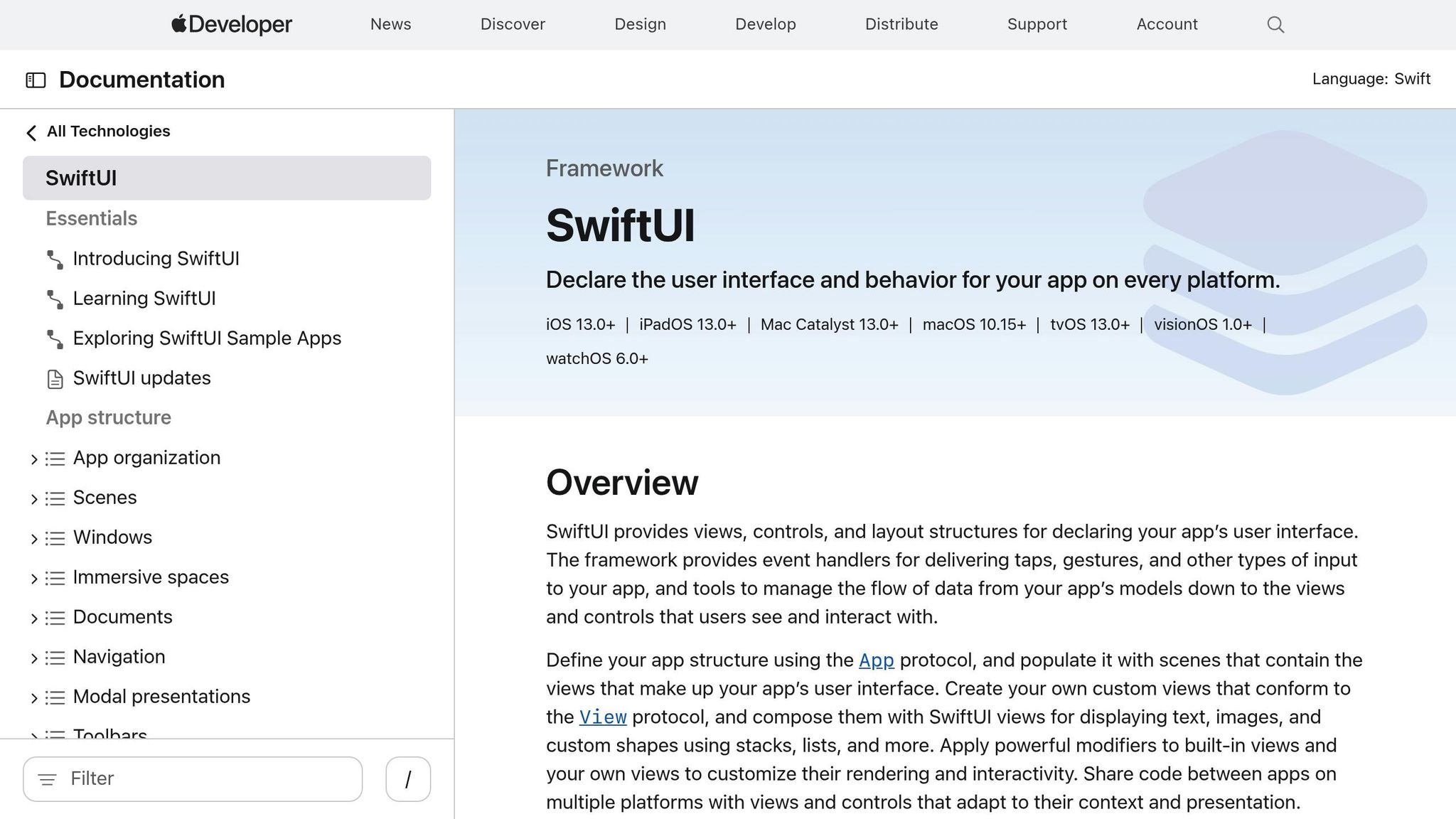Swift is the go-to programming language for iOS app development because it combines speed, safety, and modern tools. Here’s why it stands out:
- Performance: Swift’s LLVM compiler ensures apps run fast with optimized memory management.
- Security: Features like type safety, optionals, and ARC prevent bugs and protect sensitive data.
- Ease of Use: Clean syntax, Swift Playgrounds, and SwiftUI make coding and testing efficient.
- Advanced Features: Seamless integration with AR, AI, and IoT technologies.
- Business Value: Faster development, lower maintenance costs, and compliance with industry standards (e.g., HIPAA for healthcare apps).
| Feature | Benefit |
|---|---|
| LLVM Optimization | Faster app performance |
| Type Safety | Fewer runtime errors |
| SwiftUI | Simplified UI design |
| Memory Management (ARC) | Efficient and automatic memory handling |
Swift is designed for the future of iOS development, offering tools that help developers create secure, high-performance apps efficiently.
Apple’s Official Method to Learn Swift and iOS 📱

Swift’s Speed and Performance Benefits
Swift is designed to deliver high-speed performance by combining advanced compilation techniques with efficient memory management, ensuring apps run smoothly and use resources wisely.
Direct Device Code Compilation
Swift uses LLVM compiler technology to convert source code into highly optimized native code tailored for iOS devices. This process minimizes overhead through several smart techniques:
- Efficient Method Dispatch: Instead of relying on runtime lookups like
objc_msgSend, Swift uses vtables (virtual method tables) or direct function calls, which significantly speeds up execution.
"Instead of
objc_msgSend, the Swift compiler emits code that makes a call using a vtable. A vtable is just an array of function pointers, accessed by index." – Mike Ash
Additionally, marking methods as @final allows the compiler to skip vtable lookups entirely, enabling even faster direct calls in critical parts of the code.
This focus on optimized compilation is complemented by Swift’s approach to memory management, which also plays a key role in enhancing performance.
Memory Management with ARC
Swift’s memory management system, Automatic Reference Counting (ARC), eliminates the need for garbage collection, making it lightweight and efficient. Here’s how ARC works:
- Reference Tracking: ARC keeps tabs on object lifecycles.
- Memory Release: Objects are deallocated immediately when their reference count hits zero.
- Resource Efficiency: Memory is automatically recycled, reducing waste.
"ARC automatically manages memory, by deallocating an object after its lifetime ends. It determines an object’s lifetime by keeping track of its reference counts." – Meghana Gupta, Apple Developer
With tools like Xcode 13’s ‘Optimize Object Lifetimes’ feature, developers can further fine-tune memory usage, making Swift an excellent choice for handling complex operations like graphics rendering.
3D Rendering Speed Improvements
Swift shines in graphics-heavy applications, such as those designed for Apple Vision Pro, by leveraging its optimized architecture for faster rendering. Key features include:
- Hardware-Optimized Access: Swift’s pointer handling and GPU tuning reduce processing overhead.
- Direct Memory Operations: Efficient memory management minimizes delays.
- Streamlined Execution: Optimized function calls enhance the speed of rendering tasks.
This architecture allows developers to build high-performance 3D applications while maintaining clean, manageable code. Swift’s compilation process ensures that even complex rendering tasks are translated into efficient machine code, fully utilizing iOS hardware capabilities.
| Performance Feature | Benefit |
|---|---|
| LLVM Optimization | Device-specific machine instructions |
| Register Usage | Efficient parameter passing on ARM64 |
| Stack Allocation | Reduced heap allocations |
| Type Safety | Aggressive compiler optimizations |
These features make Swift a powerful tool for creating fast, responsive, and resource-efficient apps across the entire iOS ecosystem.
Security Features for Business Apps
Swift offers robust security features that make it a strong choice for business apps dealing with sensitive data and strict regulatory requirements. From type safety to reliable memory management, these built-in tools help protect against vulnerabilities.
Error Prevention Through Type Safety
One of Swift’s standout features is its strict type safety, enforced by the compiler. This ensures:
- Variables only store data of the intended type.
- Function parameters match the expected types.
- Return values align with their declared types.
- Collections maintain consistent data types.
By catching potential issues during development, this system helps prevent critical runtime errors. Paired with reliable memory management, it adds an extra layer of security for sensitive data.
Predictable Memory Management
Swift’s Automatic Reference Counting (ARC) takes care of memory management, reducing risks like buffer overflows and memory leaks. Here’s a quick breakdown of how reference types work:
| Reference Type | Usage | Benefit |
|---|---|---|
| Strong | Default reference type | Prevents objects from being deallocated prematurely |
| Weak | Optional references | Helps avoid memory leaks |
| Unowned | Non-optional references | Prevents retain cycles |
As explained on vadimbulavin.com, "The essence of Swift memory management is: Swift preserves an object if it is strongly referenced and deallocates it otherwise. The rest is just an implementation detail."
Building HIPAA-Compliant Medical Apps
Swift’s features make it well-suited for developing medical apps that meet HIPAA requirements, thanks to:
- Data Encryption: Using CryptoKit to secure sensitive patient information.
- Secure Storage: Protecting authentication credentials with the iOS Keychain.
- Network Security: Enforcing HTTPS and SSL/TLS protocols to safeguard data during transmission.
- Input Validation: Implementing strong mechanisms to prevent injection attacks.
To ensure compliance, developers can leverage Swift’s capabilities in several ways:
- Encryption Protocols: CryptoKit provides powerful tools for encrypting patient data, both at rest and in transit.
- Access Control: Swift’s type safety and memory management features help enforce strict access controls and maintain audit trails to prevent unauthorized access.
- Secure Communication: Swift’s networking tools enable end-to-end encryption, ensuring data stays protected during transfers between devices and healthcare systems.
When combined with Swift’s developer-friendly environment, these security features create a solid foundation for building secure, next-generation iOS apps tailored to the needs of businesses and healthcare providers.
Developer Tools and Efficiency
Swift doesn’t just shine in performance and security – it also equips developers with tools that streamline coding and elevate app design. These features help developers craft robust iOS apps more efficiently without compromising on code quality.
Clear Code Structure
Swift’s clean and expressive syntax reduces the chances of errors and simplifies the development process. Here’s how it helps:
- Type Inference: Swift automatically determines variable types, cutting down on repetitive code while ensuring type safety.
- Error Handling: Built-in mechanisms efficiently catch and manage errors, improving overall reliability.
This streamlined structure naturally complements Swift’s interactive tools for testing and development.
Testing with Swift Playgrounds

Swift’s structural advantages seamlessly transition into testing and prototyping workflows. Swift Playgrounds offers developers an interactive environment with instant feedback, making it a powerful tool for quick code validation. Here’s what it brings to the table:
| Feature | Benefit | Use Case |
|---|---|---|
| Live Execution | See results instantly | Testing algorithms |
| Framework Access | Work with SpriteKit, Bluetooth, and Metal directly | Prototyping features |
| SwiftUI Support | Preview interfaces in real time | UI development |
| Swift Packages | Reuse code easily | Component testing |
SwiftUI for Fast Interface Design

SwiftUI takes efficient coding a step further by simplifying user interface creation. Its declarative syntax and live previews make UI development faster and more intuitive. Some standout benefits include:
- Live Updates: Watch changes in real time as you code, thanks to Xcode’s live preview feature.
- Cross-Platform Compatibility: Use a single codebase to design interfaces for all Apple devices.
- Simplified Animation: Create smooth transitions and animations with minimal effort.
"SwiftUI uses a declarative syntax, so you can simply state what your user interface should do… Your code is simpler and easier to read than ever before, saving you time and maintenance."
– Apple Developer
sbb-itb-7af2948
Advanced Technology Integration
Swift gives developers the tools they need to tap into the latest iOS technologies, making it a go-to choice for creating advanced applications that take full advantage of Apple’s innovations.
AR, AI, and Bluetooth Features
Swift works seamlessly with frameworks like Core ML, Metal, and Combine to enable sophisticated features in modern iOS apps. Its built-in concurrency tools help manage complex AI and AR processes while keeping performance smooth and efficient.
| Framework | Primary Use | Key Benefit |
|---|---|---|
| Core ML | Machine Learning | Processes data in real-time with minimal delay |
| Metal | Graphics Processing | Delivers high-performance 3D visuals and immersive AR experiences |
| Combine | Asynchronous Events | Simplifies managing multiple data streams at once |
Modern Data Processing
Swift’s concurrency features are a game-changer for handling complex data tasks. The async/await syntax makes real-time data processing straightforward, while Swift 6’s compile-time analysis ensures safer concurrent coding by catching potential data conflicts before they cause issues.
Some standout benefits include:
- Type-Safe Operations: Protects data integrity during heavy processing tasks.
- Memory Efficiency: Automatic Reference Counting (ARC) optimizes resource management.
- Async/Await Pattern: Simplifies otherwise tricky asynchronous workflows.
These tools not only streamline data handling but also pave the way for Swift’s capabilities in industrial connectivity.
Industrial IoT Applications
Swift’s design makes it a strong contender for industrial IoT (Internet of Things) applications. Its cross-platform support, paired with the SwiftNIO framework, enables smooth communication between iOS devices and industrial systems.
Key features for IoT include:
- Real-Time Data Handling: Processes sensor data from multiple devices simultaneously.
- Secure Communications: Ensures sensitive industrial data stays protected.
- System Integration: Works effortlessly with existing industrial setups thanks to Objective-C and C++ interoperability.
In environments where reliability is non-negotiable, Swift’s safety features prevent unsafe code from creeping in, ensuring system integrity remains intact. This makes it a solid choice for building reliable, high-performance industrial applications.
Code Management and Growth
Strong code management is a cornerstone of long-term app success. While Swift’s performance and safety are well-known, its role in streamlining development and managing growth can’t be overlooked.
Working with Objective-C Code
One of Swift’s standout features is its ability to work seamlessly with Objective-C, making it easier for teams to modernize existing iOS apps without starting from scratch. This compatibility is a game-changer for gradual transitions.
Here’s how Swift integrates with Objective-C effectively:
| Integration Aspect | Implementation Method | Benefit |
|---|---|---|
| Type Safety | Nullability annotations | Reduces runtime crashes |
| API Access | Public Swift symbols | Automatically imports Swift symbols |
| Swift Features | @objc attribute |
Allows custom naming for Objective-C runtime |
| Extensions | NSObject categories | Adds Swift functionality to Objective-C |
"It’s tempting to write new code in Swift, but we can’t migrate all the existing OBJC codebase quickly. And sometimes it just isn’t worth the effort." – Adrianna Chang, Shopify Engineer
This interoperability is a foundation for building scalable and maintainable app architectures, ensuring smooth collaboration between legacy and modern code.
Protocol-Based Programming
Swift’s protocol-oriented programming (POP) model encourages the creation of reusable, type-safe code. This approach not only simplifies complex behaviors but also minimizes redundancy.
Key benefits of protocol extensions include:
- Default implementations: Reduce repetitive code while supporting multiple protocol conformances.
- Type-Safe Composition: Combine multiple protocols to define intricate behaviors without sacrificing clarity.
"With protocols and protocol extensions, Swift allows developers to enforce elaborate conformity rules without compromising the expressiveness of the language." – Aleksandr Gaidukov, Toptal Software Engineer
This programming style ensures developers can write flexible, yet highly structured code, making it easier to maintain and scale.
Swift Migration Success Story
The advantages of migrating to Swift are backed by solid metrics:
- Development Speed: Swift is 2.6x faster than Objective-C for common tasks.
- Code Efficiency: Reduces code volume significantly compared to Objective-C.
- Market Adoption: Swift has overtaken Objective-C in popularity by 1.1%.
Major platforms like LinkedIn, Twitter, and WhatsApp have embraced Swift for their iOS development. Its built-in safety features and modern syntax make it ideal for managing large-scale applications. These efficiencies not only simplify development but also contribute to long-term business growth.
Conclusion: Swift’s Business Value
Swift offers more than just technical advantages – it provides tangible benefits that align with critical business goals. Building on its performance, security, and development efficiency, Swift proves especially useful in industries where sensitive data is a concern.
For example, Swift’s strict type safety and secure memory management make it a go-to choice for sectors like healthcare and finance. These features are essential for creating HIPAA-compliant medical applications. Additionally, its modern runtime and the optimized LLVM compiler deliver speed improvements of up to 2.6 times compared to Objective-C.
Here’s a snapshot of how Swift impacts key business metrics:
| Business Metric | Swift’s Impact | Industry Benefit |
|---|---|---|
| Development Speed | 2.6x faster code execution | Accelerates time-to-market |
| Market Reach | 28.36% worldwide OS share (2023) | Expands user accessibility |
| Code Maintenance | Unified .swift file structure |
Lowers maintenance costs |
| Security | Built-in safety features | Strengthens data protection |
Swift’s direct compilation, effective ARC (Automatic Reference Counting), and robust development tools help businesses launch apps faster without compromising on quality.
"Swift code is safe by design and produces software that runs lightning-fast." – Apple Developer
Its modern ARC simplifies memory management, cutting down on development time while enhancing app reliability. These features make Swift particularly appealing for businesses aiming to deliver secure, high-performance apps.
As Ashish Parmar, Co-Founder and CEO of Prismetric, puts it: "Swift is a valuable addition to the Apple ecosystem to power the iOS applications that are secure, engaging, and perform at speed". By combining speed, security, and efficiency, Swift positions itself as an excellent choice for building scalable and reliable iOS applications.
FAQs
How does Swift’s ARC memory management boost app performance?
Swift uses Automatic Reference Counting (ARC) to handle memory management in your apps. ARC operates in the background, keeping track of objects and automatically freeing up memory when those objects are no longer in use. This helps minimize the chances of memory leaks.
By taking care of memory management for you, ARC improves app performance by avoiding wasted memory. It also lets developers spend more time creating features instead of worrying about manual memory handling. With this approach, Swift ensures your iOS apps stay efficient and dependable.
What makes Swift a secure choice for building HIPAA-compliant iOS healthcare apps?
Swift is a strong choice for building healthcare apps that meet HIPAA requirements, thanks to its built-in safety features and advanced security framework. The language helps reduce common programming mistakes with tools like type safety and automatic memory management, which can prevent issues like buffer overflows or memory leaks.
On top of that, Swift works effortlessly with Apple’s security tools, including Keychain Services for securely storing data and App Transport Security (ATS) to ensure encrypted connections. These features simplify the process of protecting sensitive patient information, making it easier to comply with HIPAA regulations. By leveraging Swift, developers can create secure and dependable iOS apps that align with the standards of the healthcare industry.
How does Swift make it easier to add advanced features like AR and AI to iOS apps?
Swift makes working with advanced technologies like augmented reality (AR) and artificial intelligence (AI) more accessible, thanks to its modern and high-performance programming environment. Its fast compiler produces optimized machine code, which is crucial for handling demanding tasks such as AR rendering and AI processing with ease.
Beyond performance, Swift’s intuitive syntax and the support of a strong developer community open the door to a variety of libraries and tools. This makes integrating sophisticated features far simpler. Plus, Swift’s compatibility with Objective-C means developers can upgrade existing apps with AR and AI functionality without needing to rebuild everything from the ground up. Designed with the future in mind, Swift ensures that iOS apps remain powerful and ready to meet the demands of an ever-evolving market.

